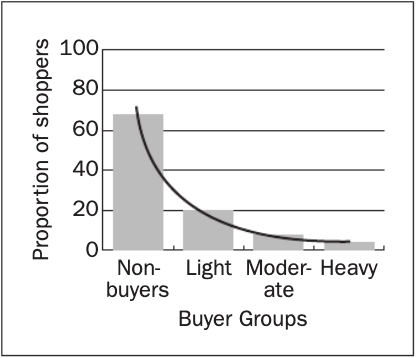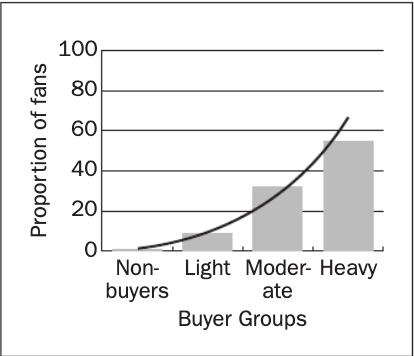Over the past few years, social media has proven its ability to drive short term business results and measure some form of tangible ROI. Brands are using social media as a tactical channel for driving short term spikes but they are not using these platforms as a brand building tool.
5 Rules of brand building
Fast and Slow
A marketer’s job is to influence people’s decision making, but to be able to influence their decisions, you must first understand how they make their decisions. Daniel Kahneman wrote in his book ‘Thinking, fast and slow’ that our brains make decisions in two ways: Fast and Slow. Fast is like being on autopilot, decisions are made using instinct and intuition. Our brains use Fast thinking 95% of the time while the other 5% of the time we’re using Slow thinking. Slow is where we have to stop and think to make a rational decision.
You need to think about how you can tailor your approach to both of these mindsets. By understanding how people think and make decisions, the better you get at influencing decisions. When people are making decisions using Slow, it’s about rationality and reason, so you need to cater to that in their messaging. Rational campaigns work best, talking about product, pricing and reasons to believe.
The long & the short of it
In their book, ‘the long and the short of it’ Les Benit and Peter Field proved that “short-term success does not necessarily lead to long-term growth”. Long-term brand effects and short term sales effects are fundamentally different things, one does not lead to the other. While both are important, they require a different approach. Short-term sales uplifts come from sales activation campaigns. They are rational and designed to generate an immediate response and should be measured over a period of weeks and months. According to Benit and Field, the primary level for long-term brand growth is brand building campaigns, designed to generate fame and prime people emotionally.
Cultural Imprinting
Back in 2014, Kevin Simler wrote about cultural imprinting and how it affects how people make decisions. He says that marketing doesn’t work through planting ideas in people’s subconscious but through creating a shared understanding within society of what a brand means. Using his logic, the mark of a strong brand is when everyone has the same understanding of what it means and what it stands for.
This means that brand building has to work on building and reinforcing the collective understanding of the brand. Everyone must buy into the same idea, it cannot be done on a one-to-one basis. Nike is a brand that has positioned itself as the brand behind athletic excellence. Over time, they have internalised this association. People who value athletic excellence will begin to feel favourably disposed to Nike and its products. Later when shopping for sportswear, for those who value athletic excellence, the positive associations and emotions will tip them towards buying Nike products.
Growth through penetration
In 2010, Byron Sharp released “how brands grow” which fundamentally opposed the way most marketers thought about the industry, making him the ultimate contrarian in marketing. 11 years later his thinking has been hugely influential.
“How brands grow’ took an evidence-based approach to how advertising really works, building a set of 7 rules about how brands achieve growth. Two of which are particularly important when it comes to brand building.
The first rule is: that brand growth comes when you gain more buyers – most of whom are considered light buyers or those who only buy the brand very occasionally. It, in contrast to what others believed, that growth could come from getting existing customers to buy your brand more frequently. However, it is now widely agreed that in most cases, growth comes through penetration. You should focus on reaching all potential buyers in your category, continuously and in the most efficient way possible when brand building.
Distinctive brand assets
The second rule is: that the purpose of advertising is to increase the mental availability of a brand – the probability of a buyer noticing, recognising and/or thinking of a brand in a buying situation. This is done by grabbing attention, being distinctive and staying top of mind. One key lever is the building and reinforcing of your ‘distinctive brand assets’, working to create mental shortcuts for potential customers. These assets are not built overnight, they take years of continuous reinforcement.
A common misconception is that this refers to a brand’s logo. It can be a logo, but it can be anything unique to the brand, a colour, tagline, a celebrity partnership or even a style of advertising. When consumers see the colour red, they usually associate it with Coca Cola and when they hear the tagline ‘there’s a glass and a half in everyone’ they think of Cadbury’s dairy milk.
There are 2 criteria when making distinctive brand assets:
- Unique – they evoke your brand and no one else’s
- Famous – most consumers can link it with your brand
What that changes?
Now that we have laid the foundations of brand building, the next step is to apply the 5 rules to how brands currently think about social media. There are 3 social media concepts that we are going to apply the brand building models to and see whether or not they’re consistent.
The three concepts are:
- Audience Growth
- Engagement
- Micro-targeting
How important are these concepts when brand building?
Audience Growth
As mentioned above, the best way to grow as a brand is to increase your penetration, by focusing on reaching all of the potential buyers in the category and not by focusing on heavy buyers. So how does that apply to social media?
Many have moved away from seeing follower growth as an indicator of success on social media but it is still an important metric. Those who follow your brand on social media are more likely to be heavy buyers. So communicating to them specifically won’t increase your penetration and grow your brand. This was proven in 2015 when the Facebook fan base of brands was compared to their customer base. Your followers are your heavy buyers.
This means if you are using social media purely as a way to communicate with your current audience, social media is not the brand building tool for you because it’s not increasing your penetration. Every bit of time and resource invested into growing followers and creating content for them to see takes away from your brand building efforts. You are better off using that time and money to go broad and communicate with all of the potential customers in your category.
Engagement
Marketers use engagement rate as one of the key metrics on social media. It’s a simple premise, out of the people a post has reached, how many have engaged with it? But what does that mean? As we mentioned previously, a brand’s followers are its heavy buyers, so those who interact with a brand’s posts are the heaviest of the heavy buyers.
Facebook does not see any value in measuring engagement for 2 reasons:
- Only a small percentage of people (>1%) who use all of the Facebook family apps will actually ever engage with posts and with the rise of dark social, this group is in decline.
- Engagement and clicks bear no correlation to brand metrics such as recall, awareness and purchase intent. Just because a post was engaging does not necessarily mean it was effective.
There is a misconception among marketers that because your engagement rate is high that you’re doing a great job at brand building. When in reality, engagement bears zero correlation to brand growth. Engagement doesn’t build brands.
Micro Targeting
One common narrative around social and digital marketing as a whole is that the advantage it offers over traditional advertising channels is the ability to micro-target. This is the concept of segmenting your target audience into smaller groups and serving them messages that is completely personalised to them. Cambridge Analytica during the run up to the Brexit referendum is a perfect example of the use of micro-targeting.
This sounds great in theory but remembering what Kevin Simler says about cultural imprinting. For brands to grow, it needs to exist in the collective consciousness. Micro-targeting is the complete opposite of this. When brands micro-target, they communicate with everyone in a way that’s completely personalised to them and what they want to hear. Micro-targeting and using social to serve completely personalised messages to different people are not engaging in brand building. It may produce short term sale uplifts but it does not contribute to long term brand growth.
Brand Building Framework
So how should you approach social media if your objective is to build your brand over the long term? There is no one size fits all approach to brand building. Every brand exists in a totally unique context and that’s why strategy is so important. But the goal here is to build a broad set of strategic principles that will help you think about brand building using social media.
A social strategy has 3 foundational elements:
- Creative
- Media
- Measurement
Creative
In the early days of social, creative was about making engaging content for the brand’s audience. The objective was to make them interact at any cost. Then, with the rise of selling through social, for many, it moved in the opposite direction – rational and action-driven was the name of the game.
So, how should brands think about social creative when brand building? While there is no simple formula for creativity, by applying the rules of brand building, a loose framework can be constructed to ensure your brand is making the right type of content.
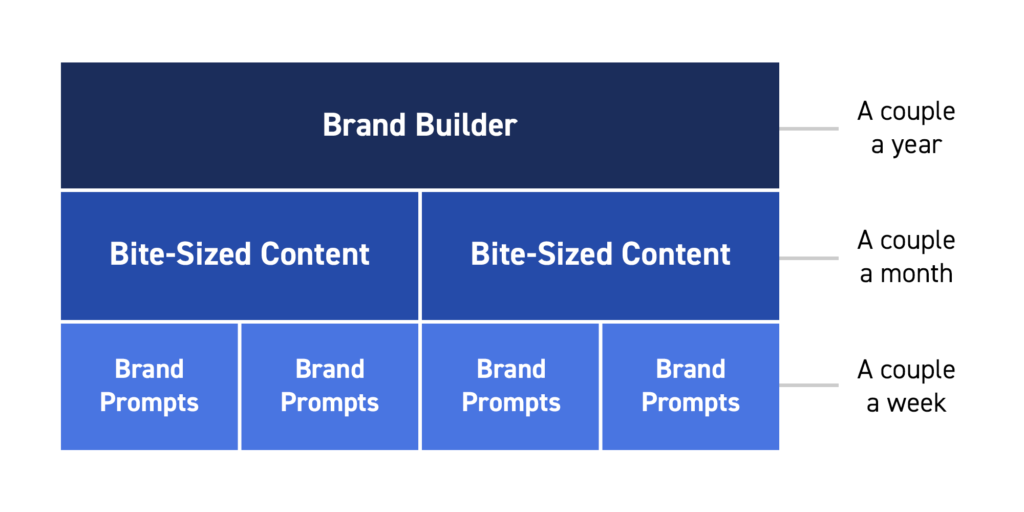 Fame builders
Fame builders
The objective is to build brand fame, which can be done by making content that creates an emotional reaction. Content that makes people feel, think, laugh or cry. Emotion over rationality. A fame builder is the hero piece of creative. It should represent the most significant investment in terms of time, production and media: this is the most important piece of content. Everyone needs to see it. It’s the work that will make the brand famous and is only needed once or twice a year.
With fame builders, its idea over everything. Get to something great before even starting to think about formats. In most cases, this content will be a long-form video, usually at least a minute or longer.
If it’s good enough, people will open the full screen, turn on the sound or stop scrolling for it – this type of content deserves to be consumed with the sound turned on, in full screen. This means it will sit most naturally in places like Facebook Watch, YouTube, Instagram feed and TikTok for you page.
Importantly, all of the potential buyers of your category should see this piece of creative, working to build that collective understanding. Even more importantly, everyone who sees it should know that everyone else has seen it – the view count can work as a subtle cue for this. Stories aren’t a great home for Fame Builders. They feel like a private experience with no view count and disappear after 24 hours.
Short Stories
The objective of short stories is to tell a story quickly. These stories work to reinforce brand fame while integrating your distinctive brand assets. The trick is to do all of that with brevity, lasting 10-15 seconds max. They are considered a hybrid between Fame Builders and Distinctive Cues and you ideally want to be running a couple of these every month. This is the bread and butter of social content. If you can only afford to do one thing on social it’s probably short stories.
Idea is still the priority but the format is also very important because the default behaviour is to scroll or swipe straight past it. This means that it needs to be social first. Stories are a great format for this, they’re full screen and often viewed with the sound on. They also force you to tell the story quickly.
To get more from less you can combine the production of your Fame Builder with Short Stories. Depending on the idea, you’re Fame Builder can be pieced up into lots of short stories.
Distinctive Cues
Distinctive cues are where brands build and reinforce their distinctive brand assets. The goal here is to continually keep your brand top of mind, fostering those mental shortcuts. John Bartle uses a great term for this – “imaginative repetition”. Your job here is to balance the need for originality demanded by social content with the need to continuously reinforce your brand assets. This is a skill and takes real creativity.
When distinctive cues are done well, they serve as a small reminder that the brand exists – cueing and reinforcing how people already feel about it. It’s really important that these distinctive cues are only effective if you’re doing the emotional work upfront with fame builders and short stories. Distinctive cues are most effective for brands that already have a good level of fame – working as small reminders and cues. They cannot work in isolation as there is nothing to cue.
Feed posts are a good home for these – but it is important to stand out and be distinctive. Loops, gifs and cinemagraphs are good executions, bearing in mind that the sound is more than likely going to be turned off when consuming this content. Stories also work well if they are short and sharp. This is a brand’s always on content with aims for 1-2 cues a week and making sure they get the reach they deserve – not relying on organic reach.
Media
When brand building, the ultimate role of media is to make sure that your content is reaching its full potential. In practice, this means 3 things.
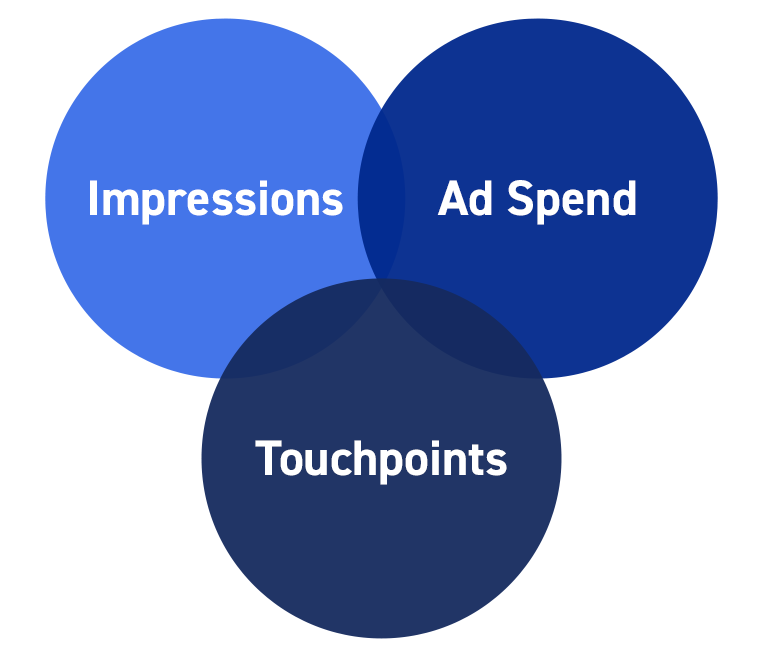
Firstly, media needs to make sure that we’re reaching enough people, at the right time and at the right cost. We need to be continuously reaching all of the potential customers in a category.
Secondly, media needs to ensure that we are reaching these people in the right places for maximum effectiveness.
Thirdly, media needs to make sure that budgets are allocated in the best way possible.
Here’s how you should approach each of these.
Reach & Frequency
Growth comes from penetration and this is driven by reaching as many potential customers as possible. Many brands spend a lot of time targeting on social and refining their audience. As we said earlier, micro-targeting does not contribute to long term growth. You should go as broad as you can afford.
The importance of frequency on social media is hugely underestimated. Impressions on social media are cheap. The default attention span on social is tiny and most impressions will have no impact. Brand building isn’t a short term job, it’s about continual reinforcement of existing structures. Basically, to make any real impact on social media, frequency is crucial. You should be aiming to reach your audience at least 1-2 times a week.
Touchpoints
You also need to ensure that you are reaching your target audience in the right places. When your budget allows, think about reaching your audience from all angles to gain a compounding effect on your effectiveness. As a starting point, think about these 3 areas:
- Platforms – Which other platforms can we reach our audience? TikTok, Snapchat, Twitter, LinkedIn etc…
- Formats – Which other formats can be used to reach our audience? Stories, Canvas etc
- Creators – How can we reach our audience outside of our brand account by using other creators? E.g. Influencer marketing, user-generated content, partnerships, sponsorships etc…
Budget Allocation
The final job of media is to ensure that the budget is being used efficiently. When dividing the social budget, it’s tempting to put more money into the channels that are seeing immediate returns. This is a mistake as it only contributes to short term sales activation and not long term brand building. While you should be spending on rational sales activation campaigns there is a happy balance. In most cases, 60% of the budget is spent on emotional priming campaigns while the remaining 40% is spent on sales activation campaigns. This can be tweaked depending on the context i.e. industry, stage of growth, demand etc.
When allocating the budget, make sure that you are spending enough on brand building work even though you are not seeing immediate returns. To grow in the long term, this is where the bulk of the budget needs to be spent.
Measurement
Measurement is crucial when it comes to social strategy. It’s how you demonstrate effectiveness and flag when things aren’t working. However, the obvious metrics are short-term focused or aren’t conducive to brand building. You need to look at long term metrics. It is important to define a measurement framework that fits your strategy but here are some starting points.
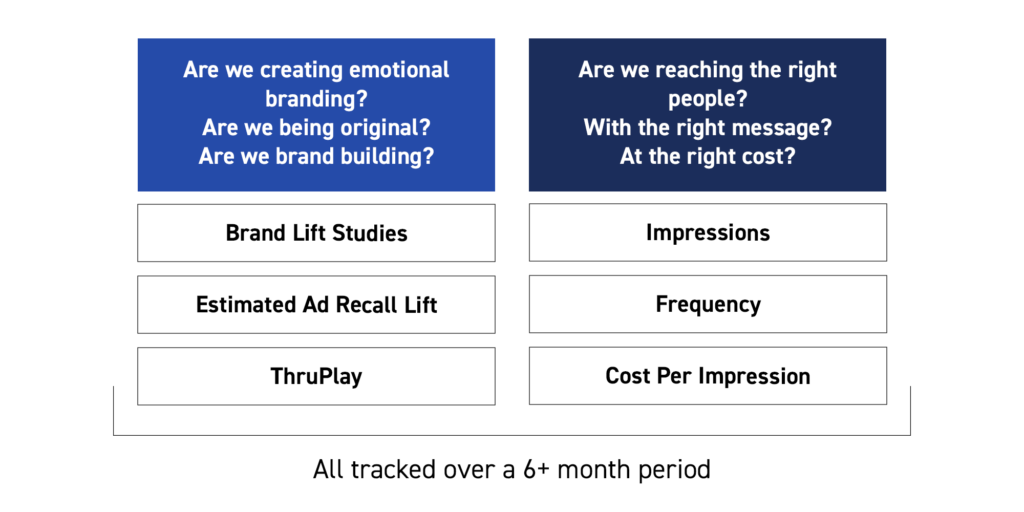 Key Takeaways
Key Takeaways
- When we are brand building we are seeking to influence Fast and Slow thinking.
- Short term sales do not lead to long term growth.
- Brand building is about building a collective understanding.
- Growth comes from all potential buyers in a category, not just the heavy ones.
- Distinctive Brand Assets are crucial to Brand Building, but they need to be reinforced consistently over the long term.
- Audience, Engagement and Micro-Targeting do not build brands.
- Social Strategy has 3 foundational elements – Creative, Media and Measurement.
- Fame Builders are content that builds brand fame through the use of emotion.
- Short Stories tell a story while working to reinforce brand fame.
- Distinctive Cues build and reinforce your distinctive brand assets.
- The role of media is to make sure that your creative is reaching its full potential.
- Reach and Frequency is a balancing act. Go as broad as your budget allows while reaching at least 80% of your audience 1-2 times a week.
- Increase the number of touchpoints and you’ll likely enjoy a compounding effect.
- Allocate 60% of your social budget to ensure that you are brand building and not just influencing short term sales.
- The platforms all nudge you towards the spikes, not the long term picture.
Want to find out how we can help you build your brand on social? Get in touch.

